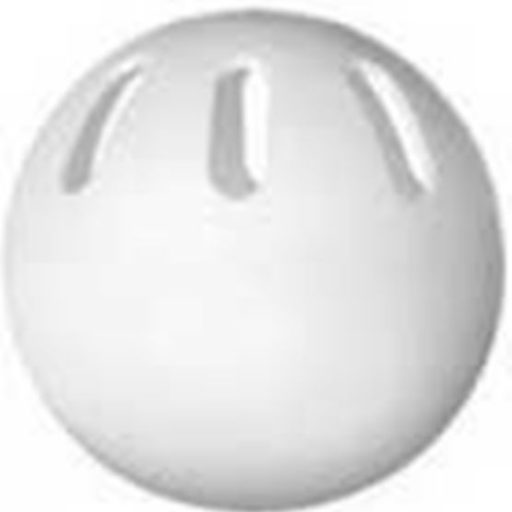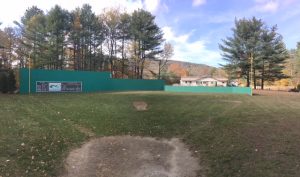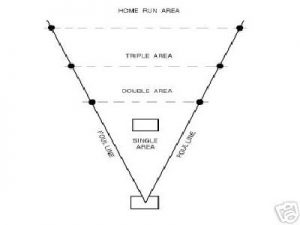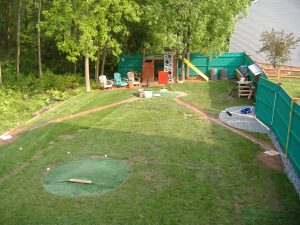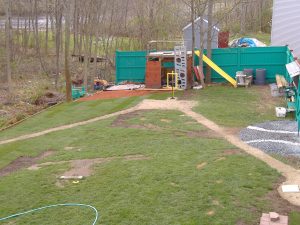Fenway Jr. wiffle ball stadium unveiled
BARTLETT — “If you build it, they will come.”

Erik Atwell didn’t have quite the epiphany that Kevin Costner had in the film “Field of Dreams,” but he had a vision and it’s become a reality. Atwell, the marketing manager at the Seasons resort, has created the ultimate Wiffle ball stadium. It pays perfect tribute to Fenway Park — home of the Boston Red Sox — and comes complete with the Green Monster, Pesky’s Pole and, yes, even, a life-sized Citgo sign.
Wiffle ball is a variation of baseball played using a perforated, light-weight, rubbery plastic ball and a long, plastic (typically yellow) bat. Atwell and his boss Bryan Stovall, general manager at the Seasons, have transformed a half acre of space into a special place, Fenway Jr. The duo affectionately refers to Fenway Jr. as “Little Field, Big Dreams” and want to see it used a fun, unique way for local organizations to hold fund-raisers.
The park is a spinoff of Little Fenway which is “a one quarter scale replica of Boston’s Fenway Park in the backyard of Pat and Beth O’Connor’s house in Essex, Vermont,” the website (littlefenway.com) states. “It was built in 2001 and is used exclusively for Wiffle ball games. Several major charity fund-raising tournaments are held at Little Fenway every year. To date, over $2 million has been raised for various charities. Smiles, laughter and warm memories are the name of the game at Little Fenway.”
“That’s what we want to do here at Fenway Jr. or Fenway Park North as you called it,” Atwell explained. “Little Fenway raised over $500,000 for local charities this summer through tournaments and events. We see Fenway Jr. as being a perfect fund-raising tool.”
“I’d heard about Little Fenway five or six years ago and I saw this empty plot here (at the Seasons),” Atwell continued. “I thought, ‘You know what, we can do something with this.’ I took the idea to my boss (Stovall) and he’s a giant Boston fan. He was, ‘I like this.’ I showed him the Little Fenway and talked to Pat O’Connor himself and sent him some emails and got his sort of blessing on this. He was like if you have the sort of passion to do this, this is a wonderful project.”
“I thought it was a wasted field down here,” Stovall said. “Erik has brought it to a different level. I wasn’t really envisioning this and then it started and now we have this. I’ve been working out here at night and we’ve had so many people coming in just wanting to check it out. Little kids are going crazy. Our Wiffle ball bats are flying off the shelf. It turned out better than I ever imagined.”
Atwell drew up some ballpark diagrams and then enlisted the services of a childhood friend, Brendan Hawkes, who along with Paul Pearson got to work building Fenway Jr.

“They put it together in about four days once thaw hit (this spring),” Atwell said. “It’s 71 feet down the line here (to the Green Monster) and 96 feet to dead center and 69 feet to the Pesky Pole. The height (of the Green Monster) is exactly the same at Little Fenway minus maybe a half foot.” The pitcher’s mound is 37 feet from home plate.
The field was given a bit of a test last Sunday with some youngsters stepping on the newest Field of Dreams with everyone giving it two enthusiastic thumbs up.
“My Jackson Little League crew came down and kind of test drove it,” Atwell said.
The first official event scheduled for Fenway Jr. takes place this Sunday at noon. The Seasons is hosting Home Runs for Literacy with all proceeds to go to the popular Believe in Books Literacy Foundation.
For just $5 participants, will get 10 swings at the fences — the Green Monster and Pesky’s Pole.
“Just for kicks we bought 192 balls and 48 bats so we’re prepared for the home run derby,” Atwell said, laughing. “We want to encourage everyone to come out and take part in a great cause,” Atwell added. “Anyone can enter and they should ask family, friends, co-workers, and colleagues if they’d be willing to pledge whatever amount they’re able to give for every home run their slugger hits. People have pledged up to $16 for every one I hit out, so a lot of pressure on me.”
Anyone interested in signing up for this event and receiving an official Home Runs for Literacy pledge sheet can inquire by emailing marketing@seasonsnh.com
To find a Citgo sign, Atwell turned to eBay this winter and got into a bidding war with fellow Red Sox enthusiasts.
“It all started to escalate in that final hour and I had authority to go up to $150,” Atwell said, smiling. “It got over $150 and I said, ‘You know what, no way, this is mine.’ I ended up getting it in the last second with a bid of $160 something.”
Getting a Citgo sign from Greenville, Mass., in the dead of winter is actually easier than you might think. “We had someone, a contractor for the Seasons, go down and get it, strap it in the back of his truck — it’s 6 feet by 6 feet and weighs a good amount,” Atwell explained. “It’s the old plastic and with the sun in the right place it looks like it’s lit.”
The park also perfectly matches the green color scheme of Fenway Park.
“Thank you colorpedia.com,” Atwell said, laughing. “I think I’ve memorized the decimal code for Fenway green.”
Waiting in the on-deck circle is Fenway Jr.’s first tournament. Wifflemania I is scheduled for Sept. 14-15. The Jimmy Fund and Youk’s Kids are supporting the tournament which will feature eight teams and as Atwell describes it, “one plastic ball,” with “eternal Wiffle ball glory” on the line. Teams interested should contact marketing@seasonsnh for more information.
“All the funds from the tournament will go to these two incredibly noble non-profit organizations that happen to have deep and meaningful ties to the Red Sox,” Atwell said. “This event provides the perfect setting for family reunions, corporate retreats or just best friends coming together for an unforgettable weekend. If you have a group of nine infielders and outfielders ready to hit the field and make memories, Fenway Jr. awaits you.”
Wiffle ball is played all over the world. The ball used in the game was invented by David N. Mullany at his home in Fairfield, Conn., in 1953 when he designed a ball that curved easily for his 12-year-old son. It was named when his son and his friends would refer to a strikeout as a “whiff.”
“It all began when our grandfather was watching our father (who was 12 years old at the time) and a friend play a game in their backyard in Fairfield, Connecticut, using a perforated plastic golf ball and a broomstick handle,” the website wiffleball.com states. “They had given up on baseball and softball – not enough players for two teams, not enough space for a field, and too many broken windows. After days of trying to throw curves and sliders with the golf ball, dad told gramp that his arm felt ‘like jelly.’ Gramp had been a semi-pro pitcher and knew that throwing curveballs was not good for young arms and thought he might be able to help. He got some parts from a nearby factory, cut various designs into them and sent dad out to test them. They both agreed that the ball with eight oblong perforations worked best. That’s how the Wiffle perforated plastic ball was invented. To this day, we don’t know exactly why it works. It just does!!
“The ball was easy to curve and harder to hit, with lots of strikeouts,” the site continued. “In our dad’s neighborhood, a strikeout was called a ‘whiff’, which led to our brand name and federal trademark registration of WIFFLE. The rules are based on the rules that dad used in his backyard games. When gramp saw how much fun dad and his friends enjoyed the game, he thought others would too. A year later, in 1953, the first WIFFLE perforated plastic balls were produced and sold. The game caught on pretty fast and now the balls are available in many countries around the world.”
According to Wickipedia.com, tournaments are the driving force of modern Wiffle ball and have been held in America and Canada since the mid-1970s. “With the explosion of the Internet in the 1990s, there are now hundreds of Wiffle ball tournaments every year in the United States and Canada. Most tournaments are annual events that happen in the same place every year but there are some tournament circuits.”
One of the longest-running Wiffle ball tournaments in the country is played right here in the Mount Washington Valley. Easy Ed’s All-Star Game celebrated its 30th consecutive year with many top Wiffle ballplayers from New England visiting the home of Pat and Kelley Murphy in Keasarge three weeks ago. Their backyard was transformed into Bob Murphy Stadium and four teams of various ages battled for bragging rights.
“Twenty-seven players and 42 innings of world-class Wiffle ball this year,” is how Pat Murphy described this year’s tournament on Facebook.
Rick West took in the day’s festivities. “A day at the Murphy’s is like a day at Disney World. Pat, Kelly and the whole Murphy clan know how to make you feel welcome,” he wrote on Facebook.” Already anticipating next year’s 31st annual Easy Ed tourney! Thanks again to all who made it a great day!”
There are some Wiffle ball enthusiasts who have taken field construction to inspiring heights just like Atwell and Stovall and Little Fenway in Vermont.
“Thomas P. Hannon Jr. authored a book, ‘Backyard Ball,’ on his experiences building a smaller

version of Ebbets Field,” Wikipedia states. “O’Connor wrote a book, ‘Little Fenway,’ about building his versions of Fenway Park and Wrigley Field. But not all Wiffle ball fields have been modeled from major league ballparks. Some have created original fields, Strawberry Field being the most exquisite. Rick Messina spent $700,000-plus on constructing Strawberry Field, which features lights for night games, bleachers and press box. He also converted a neighboring house into a clubhouse/pub.”
“Little Ebbets Field is a quarter the size of the great Ebbets Field, the hallowed ground where Robinson, Snider, Newcomb, Campy, Pee Wee Reese played. Where a team captured a city and finally won it all in 1955! Little Ebbets Field is located in Amesbury, Mass.”
“Mini Fenway in Salem, Virginia is a to-scale replica of Fenway Park (approximately a quarter of the size) that fits into the official Wiffle Ball Tournament size regulations. The park is open for free play during Salem Red Sox games (weather permitting) for all fans attending the game. The park is also reserved for any non-game-day birthday parties. Capacity at Mini Fenway is 50 fixed seats with 150 standing-room spots, while at Fenway Park it’s 37,500.”
This article appeared in the Concord Daily Sun in April 2013.
